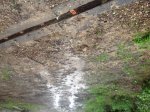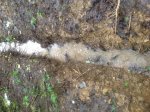pauly
Member
Equipment
2014 B2650, LA534A FEL,B2781B Snow Blower, Land Pride RCR 1260 Land Pride RB157
Looking for some thought regarding maintenance on a gravel driveway that has a fairly steep hill in one area. First a little background.
The drive is a quarter mile long. I recently had 3 quad loads of recycled asphalt mix put down and rolled/compacted. The drive is not crowned to the center and in some areas is lower than the surrounding fields. It has a straight approach than a sweeping right up hill about 150 yards long to a sweep left and then leveling off. The up hill section is cut into the side of the hill. The problem we have is in the spring with a quick snow melt off or during the summer during a heavy rain we get runoff that causes gullies to form in the down hill sections of the drive.
I realize that building up the drive so it is higher than the surrounding area would be good, but that's not practical. Putting a slight crown on the drive would help but then I would have issues with snow removal in the winter. I use a blower/rear blade combination for snow removal. I could try cutting a trough next to the drive with the rear blade so the water would have a place to runoff. Is there anything I can put on that would help keep more of the base material from running off? Like tramp oil, cement mix?
I currently maintain the drive with a home made drag harrow that works fairly well. I was looking at the Land Pride GS15 grading scraper. Would this be a good choice? Realize I do not have a roller to compact the drive.
Thanks in advance.
Paul
The drive is a quarter mile long. I recently had 3 quad loads of recycled asphalt mix put down and rolled/compacted. The drive is not crowned to the center and in some areas is lower than the surrounding fields. It has a straight approach than a sweeping right up hill about 150 yards long to a sweep left and then leveling off. The up hill section is cut into the side of the hill. The problem we have is in the spring with a quick snow melt off or during the summer during a heavy rain we get runoff that causes gullies to form in the down hill sections of the drive.
I realize that building up the drive so it is higher than the surrounding area would be good, but that's not practical. Putting a slight crown on the drive would help but then I would have issues with snow removal in the winter. I use a blower/rear blade combination for snow removal. I could try cutting a trough next to the drive with the rear blade so the water would have a place to runoff. Is there anything I can put on that would help keep more of the base material from running off? Like tramp oil, cement mix?
I currently maintain the drive with a home made drag harrow that works fairly well. I was looking at the Land Pride GS15 grading scraper. Would this be a good choice? Realize I do not have a roller to compact the drive.
Thanks in advance.
Paul



